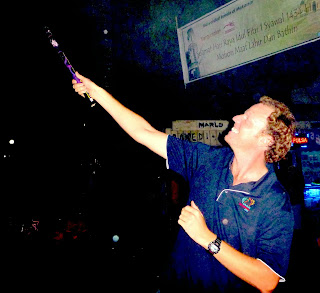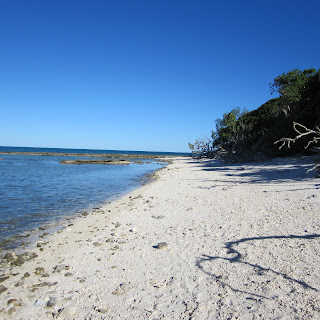As eluded to in the previous story, our time at Koh Lipe was not quite the start to our Thailand adventure that we had hoped. With the tropical low passing through a new threat lurked in our midst, the windlass (winch that pulls up the anchor) was on the blink. As we attempted to leave Koh Lipe in search of calmer waters, the windlass failed to work. After much head scratching, 'turning it off and back on again' and concerned looks between us, Hugh pulled the anchor chain up by hand. At a weight of 2.3kgs per meter of chain and 30kg of anchor at the end, Hugh pulled up 40m of chain and the anchor in 8m of water depth (some 110kgs!). An impressive feat indeed. We relocated the boat to a mooring just a few hundred meters away to have a closer look at the windlass. Upon looking at the windlass, reading the manual and checking the electrical load, the windlass was operating fine in 16m of depth. It was puzzling indeed.
We took the boat one nautical mile north on the western side of Koh Adang, a spectacular secluded spot on the side of a national park island. Gorgeous golden sand and aqua water atop a reef splayed out in front of us, this was more like what we had envisaged. We picked up a mooring and enjoyed the picturesque scenery and swam to shore. Not yet sure how long our trip to Thailand would be, we were desperate to make the most of it. Testing the windlass again while on the mooring was a success, but doubting the functioning of the 20 year old out of production winch was haunting us.
 |
| Koh Rok Nai |
The following day we sailed 40nm north to our favourite spot, Koh Rok Nai. Two national park islands (Koh Rok Nok and Koh Rok Nai) nestled together with a protected lagoon conveniently located for yachts. We picked up a mooring again and enjoyed the trip to shore, where we learned that Koh Rok Nai was the location for one of the French 'Survivor' TV series and has been living off that strange fame ever since. Thankfully due to its rather remote location at the southern end of the Andaman Sea Thai island group, it is rarely visited by the local tour operators and it was very tranquil.
After one anchoring success and picking up two more moorings, we found ourselves in one of the most visited parts of Thailand - the Phi Phi Island group. We anchored in 13m next to the boat super highway, with speed boats and longtail boats zooming past all day. It wasn't until we planned to leave the next morning that the windlass decided to give up on us and Hugh was once again on the bow pulling in 55m of chain. I went up on the bow to try and help, but after one failed whimpy attempt, I went back to my post at the wheel and Hugh continued. Once Hugh got the anchor up (to the applause of the cocktail sipping meerkats looking on from nearby boats) we made a beeline for the port town of Ao Chalong (Phuket) to work on the windlass. Trying to solve the problem of a discontinued essential piece of machinery on the boat was going to be quite the project, not one relished by us!
 |
| Dismantled windlass undergoing cleaning |
It was Saturday night, scrubbing wheel cogs with diesel to remove grease atop our dining table was not what I had in mind for a fun night in. Trying to identify the issue, which seemed to be broken bearings was part one of the process. Imbibing in a sip of wine was at least a small consolation.
 |
| Sea Wolf Windlass, case opened |
Part two came the next night, one quick name drop at the Phuket Cruising Yacht Club and Hugh had his contact - Mr Him, the Thai engineer who might just be able to divine some sort of solution for the windlass by machining the bearings. The week long process included many trips to Mr Him's workshop, one which saw Hugh driving a motorbike in crazy Phuket traffic with the windlass cradled between his knees, to deliver the critical carcass for further inspection. The other trips involved much sign language and looking for examples to break the language barrier.
5 days after first contact with Mr Him, we were gluing the windlass onto the deck, reconnecting the electrical system, undertaking final last checks and weighing anchor to sail off to Raileh Beach in search of that Thai paradise we were dreaming of. This was more like it!
5 days after first contact with Mr Him, we were gluing the windlass onto the deck, reconnecting the electrical system, undertaking final last checks and weighing anchor to sail off to Raileh Beach in search of that Thai paradise we were dreaming of. This was more like it!



























